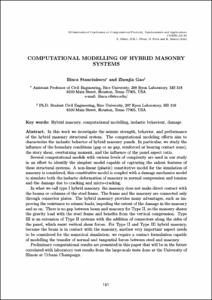Mostra el registre d'ítem simple
Computational modelling of hybrid masonry systems
| dc.contributor.author | Stanciulescu, Ilinca |
| dc.contributor.author | Gao, Zhenjia |
| dc.date.accessioned | 2020-04-16T08:56:21Z |
| dc.date.available | 2020-04-16T08:56:21Z |
| dc.date.issued | 2011 |
| dc.identifier.citation | Stanciulescu, I.; Gao, Z. Computational modelling of hybrid masonry systems. A: COMPLAS XI. "COMPLAS XI : proceedings of the XI International Conference on Computational Plasticity : fundamentals and applications". CIMNE, 2011, p. 181-188. |
| dc.identifier.isbn | 978-84-89925-73-1 |
| dc.identifier.uri | http://hdl.handle.net/2117/183546 |
| dc.description.abstract | In this work we investigate the seismic strength, behavior, and performance of the hybrid masonry structural system. The computational modeling efforts aim to characterize the inelastic behavior of hybrid masonry panels. In particular, we study the influence of the boundary conditions (gap or no gap, reinforced or bearing contact zone), the story shear, overturning moment, and the influence of the panel aspect ratio. Several computational models with various levels of complexity are used in our study in an effort to identify the simplest model capable of capturing the salient features of these structural systems. A non-linear (plastic) constitutive model for the simulation of masonry is considered; this constitutive model is coupled with a damage mechanics model to simulate both the inelastic deformation of masonry in normal compression and tension and the damage due to cracking and micro-cracking. In what we call type I hybrid masonry, the masonry does not make direct contact with the beams or columns of the steel frame. The frame and the masonry are connected only through connector plates. The hybrid masonry provides many advantages, such as improving the resistance to seismic loads, impeding the extent of the damage in the masonry and so on. There is no gap between beam and masonry for Type II, so the masonry shares the gravity load with the steel frame and benefits from the vertical compression. Type III is an extension of Type II systems with the addition of connectors along the sides of the panel, which resist vertical shear forces. For Type II and Type III hybrid masonry, because the beam is in contact with the masonry, another very important aspect needs to be considered for the numerical simulation: we require a contact formulation capable of modelling the transfer of normal and tangential forces between steel and masonry. Preliminary computational results are presented in this paper that will be in the future correlated with laboratory test results from the large-scale tests done at the University of Illinois at Urbana Champaign. |
| dc.format.extent | 8 p. |
| dc.language.iso | eng |
| dc.publisher | CIMNE |
| dc.subject | Àrees temàtiques de la UPC::Matemàtiques i estadística::Anàlisi numèrica::Mètodes en elements finits |
| dc.subject.lcsh | Finite element method |
| dc.subject.lcsh | Plasticity -- Mathematical models |
| dc.subject.lcsh | Plasticity |
| dc.subject.other | Hybrid masonry, computational modelling, inelastic behaviour, damage |
| dc.title | Computational modelling of hybrid masonry systems |
| dc.type | Conference report |
| dc.subject.lemac | Elements finits, Mètode dels |
| dc.subject.lemac | Plasticitat -- Models matemàtics |
| dc.subject.lemac | Plasticitat |
| dc.rights.access | Open Access |
| local.citation.contributor | COMPLAS XI |
| local.citation.publicationName | COMPLAS XI : proceedings of the XI International Conference on Computational Plasticity : fundamentals and applications |
| local.citation.startingPage | 181 |
| local.citation.endingPage | 188 |


